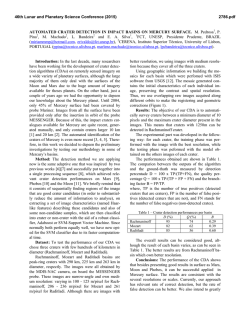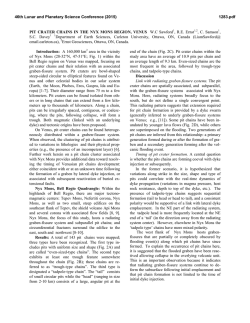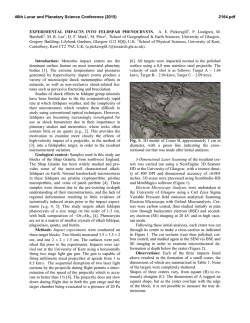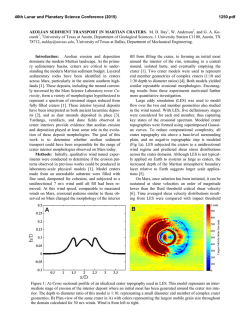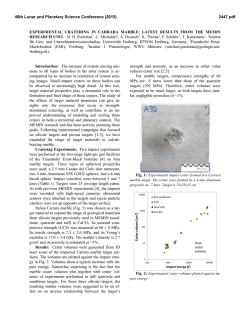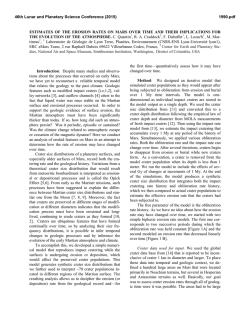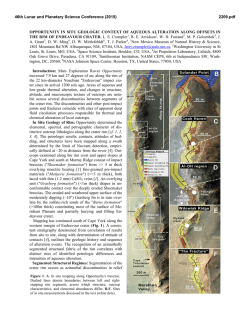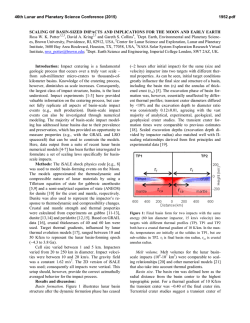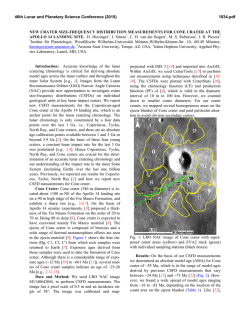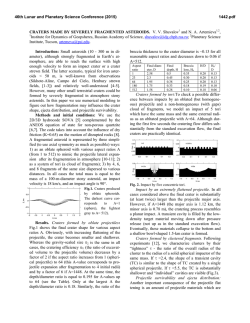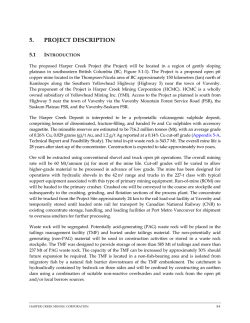
DETAILED MORPHOLOGICAL AND STRUCTURAL MAPPING AND
46th Lunar and Planetary Science Conference (2015) 2944.pdf DETAILED MORPHOLOGICAL AND STRUCTURAL MAPPING AND ANALYSIS OF ESIRA, A CENTRAL PIT CRATER NEAR HYPANIS VALLIS. A. Maine1, N. G. Barlow2 and L. L. Tornabene3, 1School of Earth Science and Environmental Sustainability, Northern Arizona University, Flagstaff, AZ 86001, [email protected], 2Dept. of Physics and Astronomy, Northern Arizona University, Flagstaff, AZ 86001, 3University of Western Ontario, Centre for Planetary Science and Exploration, Earth Sciences, London, ON, Canada N6A 5B7. Introduction: Central pit craters are a complex impact crater with a pit either on the crater floor (floor pits) or atop a central peak (summit pits) [1]. They encompass only 5% of the total crater population on Mars [2]. Formation models of central pit formation typically invoke the presence of target volatiles, with some models proposing collapse of the central region to form the pit while others involve uplift followed by collapse [3,4,5,6,7,8]. The goal of this project is to provide insights into the formation mechanism of central pit craters on Mars. We are conducting a detailed investigation of several representative central pit craters from different regions of Mars to determine common characteristics of the pits. The detailed investigation includes mapping the morphology and structure of the central pit region with great precision. The first crater we have chosen has recently been named Esira (Fig. 1), which is 16.3 km in diameter and located within the Lunae Planum quadrangle just south of Hypanis Valles (centered at 8.9N, 313.4E), a region being considered as a landing site for ESA’s ExoMars 2018 rover [9]. Figure 1: Esira Crater. Box within crater shows the lateral extent of the morphologic and structural maps. (PSP_009393_1890_Red, B01_010105_1892_XN_09N046W) Background: Impact events are known to form a series of fractures and faults underneath the crater floor [10]. Although these faults are rarely seen, expressions of these faults might penetrate to the surface. Central pit craters may be one of the few cases where the faults create a unique and uplifted and observable placement of material within the crater floor. One of the distinguishing features of floor pit craters is the presence or absence of a pit rim, which ranges from no rim at all to having a partial rim to a complete rim [11]. We have classified Esira is a partially-rimmed type. Pit rims are similar to crater rims where they are a topographic high and are distinguished by a sharp slope into the pit. Methods: Esira Crater was selected for this study because it is a well-preserved floor pit crater with good data coverage. The main datasets that we used for mapping included the MRO Context Camera (CTX) and the MRO High Resolution Imaging Science Experiment (HiRISE). The CTX image, the CTX DTM [12, 13], the HiRISE image, and the HiRISE anaglyph were all used to ensure the best coverage and different perspectives of Esira. We utilized the CTX DTM rather than the HiRISE DTM because the latter only covered about ¾ of the central pit. The lateral extent of the maps was chosen to allow us to focus on the pit itself as well as about half of the crater floor and can be seen in Fig. 1. The remainder of the crater floor did not provide any insights into the pit characteristics and thus was not included in the maps. The Morphological Map. We have identified four units on our morphologic map of Esira (Fig. 2). The rim of the pit is characterized by the sharp ridge unit, which can be recognized by its sharp ridges that appear to be bedrock layers and un-pitted surfaces. The pitted material unit lies within the crater floor and the central pit. It appears darker than most of the other material within the crater floor. It is distinguished by its oblong, sometimes connected pits, forming a polygonal type pattern. The aeolian bedforms unit is expressed as a massive dune field. Each dune was chosen because it was at least 100 meters long and completely obscured the layer beneath it. The logic behind taking such care in outlining the dunes was in order to see how ubiquitous the pitted material was that lays beneath the dunes. The last unit is varying tones or unidentified tones of colluvium. We found that the colluvium obscured whatever unit it was emplaced upon, within the central pit and just outside of the central pit’s rim. It is either dusty or unconsolidated blocky material. Figure 2: The outline of the morphologic map nearing it’s final stage of completion. The final map will have every unit color coded. The Structural Maps. The first structural map (Fig. 3) contains the central pit rim, the most defined pitted materials’ crests, the crests of the ridge-building material, and the largest of the visible craters within the 46th Lunar and Planetary Science Conference (2015) crater and the central pit. The pit rim was traced around the CTX DTM contour that appeared to define the pit most appropriately. The reason for including craters in this map was to show the difference between the pitted material and craters. Although pitted material and the fresher, clearly defined craters both exhibit a rim/topographically-elevated crest, craters are much more circular and do not connect in most cases. Figure 3: First structural map. Orange is pit rim. Pink is sharp ridges. Purple is pitted material. Blue is craters. Figure 4: Inferred faults map. Blue lines encircle fault blocks. The second structural map (Fig. 4) is exclusively for the “inferred faults” within the central pit/crater system. We are calling all of the faults inferred because, even with HiRISE, the amount of dust and other materials eliminate any chance of seeing offset or actual fault exposures. We know the faults must exist because many faults are produced during the impact event, in addition to undeniable uplift in the western section of the pit rim. Observations: The pit is deepest on the North-East side whereas the crater is deepest in the Northern portion of the floor. The rim of the pit is the highest on the western side. The crater is located on angled topography. The lower elevation is towards the North and Hypanis Valles. Several types of deposits are observed within the crater and the pit itself: pitted material, dunes, and colluvial debris. The pitted material has been shown to be an impact melt deposit, based on previous studies [14], most likely forming in the late stage of the crater modification. Pitted materials are found most commonly in the most pristine craters, suggesting that these pits are easily destroyed by erosion and/or infilling. These pits are likely impactites or impact melt deposits and formed of volatile rich mineral and lithic fragments [14]. The other unit seen in the morphologic map consists of megablocks formed of bedrock. This bedrock is impossible to further characterize, since it is covered with a fine layer of dust when it is not covered by colluvial debris. 2944.pdf Stratigraphically, the units from bottom to top are the sharp ridge unit, the pitted material, the aeolian deposit and then the colluvial material. Discussion: Pitted material located on the crater floor in addition to the central pit places a significant constraint on the timing of the pit formation relative to crater formation. The pitted materials appears to coat and to “flow” into the pit, indicating that the pit formed before the impact melt completely solidified. The pitted material showed densly situated and smaller scaled pits on the North-West side of the crater floor than anywhere else within the crater. Additional unit asymmetry was found with other morphologic units. The sharp ridged unit is most pronounced on the west side of the central pit rim. The colluvium is an artifact of the steep gradient of the sharp ridges and so naturally is found to be concentrated on the western side of the central pit. The dunes were mostly concentrated on the western side of the crater floor as well. The location of the dunes is an indicator of wind direction, which can help identify preferential erosion in some areas. The fault blocks within the fault map appear to have been uplifted to have created the pit rim. The faults are radially situated and it is possible, although it can not be proven that the blocks have been rotated. Major brecciation and uplift have been associated with the formation of the central pit. Conclusions and Future Work: The morphologic map of Esira indicate that pit formation occurs contemporaneously with crater formation, prior to solidification of impact melt on the crater floor. The structural maps indicate that Esira’s partial pit rim was formed by uplift. This is inconsistent with pit formation models where only collapse occurs. Detailed morphologic and structural mapping of additional floor and summit pit craters will allow us to better constrain the formation mechanism(s) involved in central pit formation on Mars. Acknowledgements: This work is supported by the NASA MDAP award NNX12AJ31G. We thank MOLA, CTX, and HiRISE teams for their datasets. We also thank Trent Hare and Corey Fortezzo for their invaluable assistance with the mapping. References: [1] Hale, W. S. and Head, J. W. (1981) ICM, LPI 104. [2] Barlow N.G. (2014) Large Meteorite Impacts and Planetary Evolution V, submitted. [3] Wood, C., Head, J., and Cintala, M. (1978) Proc. LSC 9, 3691–3709. [4] Croft, S. K. (1981) LPS XII (abstract), 196-198. [5] Greeley, R., et al. (1982) Univ. AZ Press, Tucson, 340-378. [6] Passey, Q. R. and Shoemaker, E. M. (1982) In Satellites of Jupiter (D. Morrison, ed.), Univ. AZ Press, Tuscon, 379-434. [7] Croft S. K. (1983) JGR 88:B71–B89. [8] Williams, N. R., Bell III, J. F., Christensen, P. R., and Farmer, J. D. (2014) 5 th PCC Abstract. [9] http://www.esa.int/Our_Activities/Space_Science/Four_candidate_landing_sites_for_ExoMars_2018. [10] Melosh, H. J. (1989) Impact cratering: a geologic process. Oxf. U. Press. [11] Garner, K. M. L. and Barlow, N. G. (2012). LPSC, Abstract #1256. [12] Kim, J. R., and Muller, J-P., (2009) PSS, 57 (15), 2095-2112. [13] Kim, J.R., Lin, S.H., Choi, Y.S., Kim, Y.H., (2013) EPS. [14]Tornabene, L. L., et al. (2012) Icarus, 220, 348-368.
© Copyright 2025

